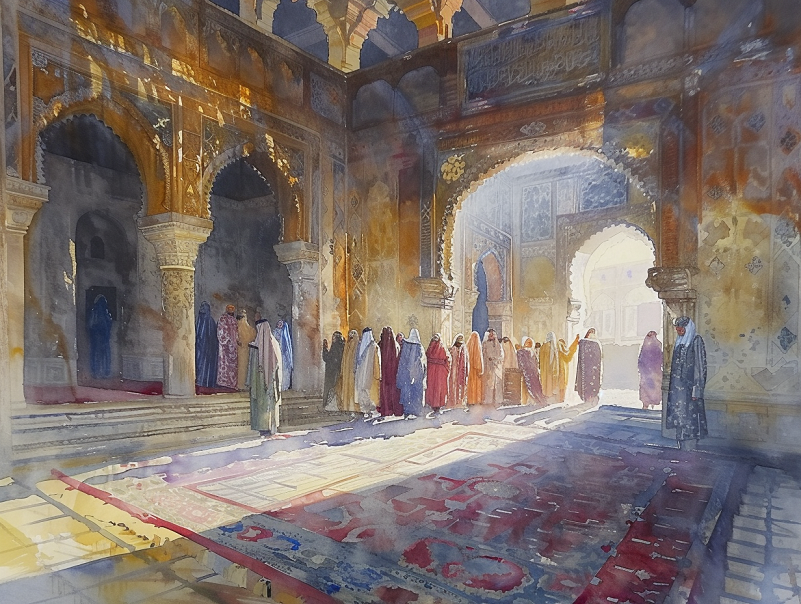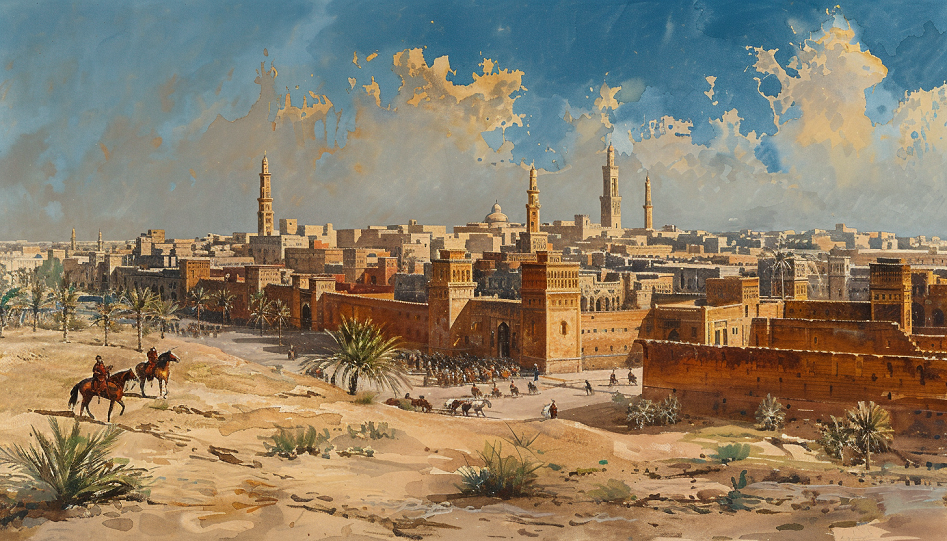In the early 20th century, Harry St. John Philby embarked on an extraordinary journey into the heart of the Arabian Peninsula, chronicling his experiences in the seminal work, “Heart of Arabia.” This narrative offers an unparalleled glimpse into the life and culture of Saudi Arabia, detailing Philby’s interactions with key figures, his observations of Riyadh, and the customs and traditions of its people. Through Philby’s eyes, we explore the landscapes of Riyadh, engage with members of the royal household, and delve into the social fabric of a society standing at the crossroads of tradition and change. His account, rich with detail and insight, serves as a valuable historical document, shedding light on the dynamics of Saudi Arabia and its significance within the broader context of Middle Eastern history.
Arrival at Riyadh
Upon his arrival at Riyadh, Philby’s first encounter was marked by a vivid tableau of desert life and hospitality. Standing on the ridge overlooking the city, he and his companions were swiftly greeted by three horsemen, a moment that signalled their entry into the heart of Saudi Arabian society. Among these horsemen was ‘Aidh, a precursor to the group, who introduced his companions: Sa’id, a slave of the royal household, and Ibrahim ibn Jumai’a, a figure who would become a significant yet contentious presence in Philby’s narrative. Philby’s instant “strong instinctive dislike” towards Ibrahim ibn Jumai’a sets the stage for a complex relationship, hinting at the deeper social and personal intricacies he would navigate during his stay.
This initial meeting was more than a simple welcome; it was a rite of passage into the city’s social and cultural life. The group’s descent towards Riyadh, escorted by Ibrahim, unfolded amidst exchanges of news and compliments, reflecting the Arab tradition of hospitality and the importance of formal greetings. The encounter with Colonel Hamilton, the Political Agent at Kuwait, further underscored the interconnectedness of regional politics and the pivotal role of Riyadh as a centre of diplomatic activity. This blending of personal introductions and political undertones exemplifies the multifaceted nature of Philby’s expedition, capturing the essence of Riyadh as a city poised between tradition and the burgeoning influence of external relations.
Meeting with Ibn Sa’ud at the Royal Palace
Philby’s entrance into the palatial confines marked a significant moment, encapsulating the opulence and the stringent adherence to tradition within the Saudi royal household. The warmth of the reception, first by ‘Abdulrahman and then by Ibn Sa’ud himself, illustrated the deeply ingrained customs of hospitality that define Saudi Arabian culture. This initial interaction, characterized by much cordiality from a “little old man, somewhat inclined to stoutness, sharp-featured and bright-eyed,” reveals the personal dimensions of Philby’s journey, juxtaposed against the backdrop of his broader geopolitical pursuits.
The narrative underscores the cultural nuances observed during this meeting, particularly the deference shown by Ibn Sa’ud towards his father, ‘Abdulrahman, adhering to the “strict observance of the canons of family etiquette.” This scene, where the ruler of “Wahhabiland” humbled himself in the presence of his father, mirrors the profound respect for hierarchical family structures within Saudi society. Philby’s reflection on this aspect, “by a sort of instinct I became aware of another presence in the room,” underscores the subtleties of social interactions and the unspoken codes of conduct that govern Saudi Arabian life.

Accommodations and Hospitality
Following the formalities of their reception, Philby and his companions were shown to their accommodations within the palace—a gesture that speaks to the Saudi tradition of guest hospitality. Their suite, as described by Philby, offers a glimpse into the architectural and domestic arrangements typical of Riyadh’s elite residences. This space, “usually reserved by Ibn Sa’ud for the occupation of any Baduwiyya he might take to himself as wife,” not only provided a comfortable abode for the guests but also served as a symbol of the intertwining of personal and political life within the royal household.
The provision of such quarters, replete with mats, carpets, and cushions, and the segregation from the household’s daily operations, highlight the importance placed on privacy and respect for guests. This practice of hospitality, deeply embedded in Arab culture, is further exemplified by the princely repast served to Philby and his party, marking their full integration into the host’s social world. Through these gestures, Ibn Sa’ud not only extended his welcome but also demonstrated the values of generosity and respect that are paramount in Saudi Arabian society.
Riyadh — The City and its Surroundings
Amidst the whirlwind of official duties and diplomatic dialogues with Ibn Sa’ud, Philby found his time for exploration of Riyadh and its environs significantly limited. Despite these constraints, his narrative does not fail to convey the essence and vibrancy of the Wahhabi capital, albeit through a lens focused primarily on the engagements that brought him there. Philby’s acknowledgment of his restricted ability to roam freely and immerse himself in the city’s daily life hints at a deeper longing to connect with the land and its people beyond the confines of his mission. He writes, “my time was so fully occupied with the official business of my Mission,” illustrating the constant balancing act between his roles as an observer and a participant in the unfolding political narrative.
Even with limited leisure to study Riyadh’s life and topography in depth, Philby was content to reserve his exploration for future endeavors, aware of the rich tapestry of experiences that awaited him. His decision to focus on the official aspects of his visit does not diminish the value of his observations; rather, it sets the stage for a more detailed examination of Riyadh’s social and cultural landscape in subsequent accounts. This approach reflects a pragmatic acceptance of his circumstances, coupled with an unwavering curiosity about the city and its inhabitants.
Philby’s brief commentary on the city’s atmosphere during his sojourn offers a snapshot of Riyadh as a center of power and tradition within the broader context of Wahhabiland. Despite the brevity of his descriptions, the narrative serves as a bridge to understanding the complexities of a society at a pivotal moment in its history. Through Philby’s eyes, Riyadh emerges not just as a geographical location, but as a living entity, pulsating with the rhythms of daily life and the undercurrents of political change.
Key Personalities and Interactions
The tapestry of Philby’s narrative is enriched by the spectrum of personalities he encounters, each adding depth and color to his Arabian journey. ‘Aidh, Ibrahim ibn Jumai’a, Colonel Hamilton, and ‘Abdullah Sa’id Effendi emerge not merely as characters in Philby’s story but as representatives of the diverse facets of Arabian society and British diplomatic interests in the region. Their interactions with Philby offer insights into the complexities of Saudi social structures, political dynamics, and the intricacies of intercultural diplomacy.
Ibrahim ibn Jumai’a stands out as a particularly significant figure, embodying the challenges and nuances of Philby’s experience in Riyadh. His initial introduction, where Philby confesses to taking an “instinctive dislike” towards him, underscores the personal dimensions of international relations and the subjective nature of cross-cultural encounters. Ibrahim’s role as both a facilitator and a challenge in Philby’s journey highlights the delicate balance of power, perception, and personality that defines diplomatic engagements.
Philby’s Relationship with Ibrahim ibn Jumai’a
The evolving dynamic between Philby and Ibrahim ibn Jumai’a serves as a microcosm of the broader narrative of cultural and political negotiation. Philby’s growing antipathy towards Ibrahim, culminating in an “open rupture” more than six months into his stay, illustrates the tensions that can arise when differing worldviews and personal agendas intersect. This relationship, marked by initial distrust and eventual conflict, provides a candid look at the challenges inherent in forging connections across cultural divides.
Yet, it is through such personal narratives that the essence of Philby’s experience in Saudi Arabia is revealed. The interactions between Philby and the figures he encounters are not merely anecdotes but pivotal moments that shape his understanding of the region and its people. These relationships, with their complexities and contradictions, paint a vivid picture of the Arabian Peninsula during a time of significant transition, as seen through the eyes of a British explorer navigating the intricate web of social, political, and personal landscapes.
Cultural and Social Etiquette
Philby’s observations shed light on the profound respect for traditional practices within Saudi Arabian society, particularly in the realms of religion and family. The meticulous observance of prayer times, with the city gates closing to honor the weekly public prayer, encapsulates the spiritual devotion that permeates everyday life in Riyadh. This ritual, far from being a mere formality, symbolizes the collective adherence to faith that defines the community’s rhythm.
The reverence for family hierarchy is equally poignant, as illustrated by the interaction between Ibn Sa’ud and his father, ‘Abdulrahman. Philby’s reflection on this dynamic, noting how Ibn Sa’ud “humbled and effaced himself in obedience to the laws of God,” speaks to the deep-seated values of respect and deference ingrained in Saudi culture. Such moments reveal the intricate balance between personal authority and communal reverence, highlighting the societal norms that govern interpersonal relations.

Harry St. John Philby’s journey into the heart of Saudi Arabia, as narrated in “Heart of Arabia,” presents a rich tapestry of cultural encounters, political dialogues, and personal reflections. Through his detailed account of Riyadh and its inhabitants, Philby offers a unique window into the early 20th-century Arabian Peninsula, marked by its adherence to tradition, the warmth of its hospitality, and the complexities of its social and political structures.

